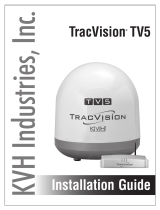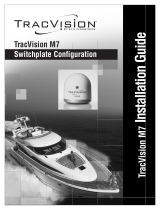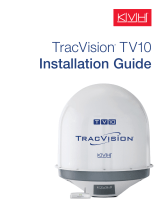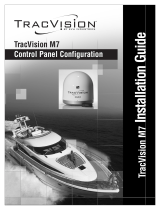Page is loading ...

KVH, TracVision, and the unique light-colored dome with dark contrasting baseplate are registered trademarks of KVH Industries, Inc.
All other trademarks are property of their respective companies. The information in this document is subject to change without notice.
No company shall be liable for errors contained herein. © 2017-2018 KVH Industries, Inc., All rights reserved. 54-1257 Rev. B| 72-0825 1
TracVision TV3/TV5/TV6/TV8
Sky Mexico LNB Conversion Instructions
Technical Support
If you need technical assistance, please contact KVH Technical Support:
North/South America, Australasia:
Phone: +1 401 847-3327
Email: [email protected]
Europe, Middle East, Asia-Pacific, Africa:
Phone: +45 45 160 180
Email: suppor[email protected]
The following instructions explain how to replace
the LNB in your TracVision® antenna with a
stacked linear Sky Mexico LNB.
Tools Required
This procedure requires the following tools:
• Phillips screwdrivers
• #2 Phillips torque screwdriver set to
21 in-lbs
•Wire cutters
• Torque wrench with:
7/16" bit (15 in-lbs)
2 mm Allen hex bit (11 in-lbs)
• Laptop computer with the latest software
downloaded via the KVH Partner Portal, or an
Apple® iOS or Android™ smartphone/tablet
with the latest software downloaded via the
TracVision TV/RV mobile app
Initial Steps
Follow the steps below to begin the procedure by
removing the radome to access the LNB.
Important!
These instructions assume you will connect to the
79°W satellite for service and are not applicable for
service obtained through the 58°W satellite.
Figure 1: Sky Mexico LNB

2
a. Power off and unplug the TV-Hub to disconnect
power from the antenna.
b. Remove and discard the screws securing the
radome to the baseplate (see Figure 2). Carefully
lift the radome straight up until clear of the
antenna assembly and set it aside in a safe place.
If you keep the radome topside, secure it with a
lanyard to prevent it from falling overboard. Do
not place the radome on a hot steel deck – the
heat may warp the radome.
c. Follow the steps on the associated page below,
next to your antenna model, to convert to a
stacked linear Sky Mexico LNB:
CAUTION
To prevent injury, be sure to disconnect all
power from the antenna before proceeding.
Power must remain disconnected for the
duration of this procedure.
Antenna Model Page
TracVision TV3 3
TracVision TV5 5
TracVision TV6 7
TracVision TV8 9
Figure 2: Radome Screws (TV3 Shown)

3
Converting a TracVision TV3 LNB
Follow the steps below to convert to a stacked linear
Sky Mexico LNB in a TracVision TV3 antenna.
Removing the Old LNB
a. Disconnect all RF cables from the LNB (see
Figure 3).
b. If you are removing a circular LNB, remove
and discard the eight #8-32 screws and washers
securing the LNB, feed tube, and gyro mounting
bracket to the reflector (see Figure 4). Let the
gyro mounting bracket hang down and
carefully remove the LNB and the feed tube. Set
the feed tube aside in a safe place.
Then continue to step c on page 4.
Otherwise, use a 2 mm Allen hex key to loosen
the two M4 set screws securing the LNB in the
choke feed (see Figure 3) and remove the LNB
from the choke feed.
Then skip to step d on page 4.
Figure 3: TV3 Cable Routing (Linear Universal Dual LNB Shown)
Figure 4: TV3 #8-32 Screws and Washers

4
Installing the New LNB
c. If you are converting from a circular LNB:
c1. Secure the new choke feed and gyro bracket
to the reflector with four new #8-32 screws
(KVH part no. 14-0041-04N) and washers
(supplied in kit).
c2. Secure the feed tube to the reflector with
four new #8-32 screws (KVH part no.
14-0041-05N), as shown in Figure 4 on
page 3. Then tighten all eight screws to
21 in-lbs of torque.
c3. Place the skew label sticker (supplied in kit)
on the choke feed, ensuring that the 0° line is
perfectly vertical (see Figure 5). Press firmly,
so that it adheres to the choke feed.
d. Insert the new LNB fully in the choke feed. Then
tighten the choke feed set screws with a 2 mm
Allen hex key to 11 in-lbs of torque (see Figure 3
on page 3). You will access the Setup Wizard
later to obtain the correct skew angle.
e. Route and secure the RF cable(s) with one or
two tie-wraps, as shown in Figure 6 and
Figure 7.
f. Connect the RF1 cable to the LNB. Then tighten
the cable to 15 in-lbs of torque.
g. If a second RF cable is present, protect the
RF connector with a rubber cap (supplied in kit),
as shown in Figure 7.
Continue to page 11 to wire the belowdecks
equipment for use with your new LNB.
Important!
Maintain a minimum bend radius of 1/2" (1.3 cm)
when routing the RF cable to the LNB. Sharp bends
or kinks in the cable can degrade antenna
performance.
Figure 5: Skew Label Placement (TV3 Shown)
Figure 6: Stacked Linear LNB Wire Routing (Single RF Cable TV3 Shown)
Figure 7: Stacked Linear LNB Wire Routing (Dual RF Cable TV3 Shown)

5
Converting a TracVision TV5 LNB
Follow the steps below to convert to a stacked linear
Sky Mexico LNB in a TracVision TV5 antenna.
Removing the Old LNB
a. Disconnect all RF cables from the LNB (see
Figure 8).
b. Remove any tie-wraps securing the RF cables to
the LNB.
c. Using a 2 mm Allen hex key, loosen the two
(manual skew) or three (auto skew) M4 set
screws securing the LNB in the choke feed (see
Figure 9).
d. Remove the LNB from the choke feed.
Figure 8: TV5 Cable Routing (Linear Universal Quad LNB Shown)
Figure 9: TV5 Set Screws

6
Installing the New LNB
e. Insert the new LNB fully in the choke feed.
f. If you are installing an LNB in an auto skew
antenna, position the new LNB so that it is in
line with the skew motor, as shown in Figure 10.
Then tighten the choke feed set screws with a
2 mm Allen hex key to 11 in-lbs of torque (see
Figure 9 on page 5).
If you are installing an LNB in a manual skew
antenna, tighten the choke feed set screws with a
2 mm Allen hex key to 11 in-lbs of torque (see
Figure 9 on page 5). You will access the Setup
Wizard later to obtain the correct skew angle.
g. Route and secure the RF2, RF3, and RF4 cables
with one or two tie-wraps, as shown in
Figure 10 or Figure 11. Then protect the
RF connectors with rubber caps (supplied in kit).
h. Connect the RF1 cable to the LNB. Then tighten
the cable to 15 in-lbs of torque.
i. If you have an auto skew antenna (see
Figure 10), ensure that the skew motor
assembly will freely rotate ±105° from the skew
limit switch, at all elevations, without
obstruction.
Continue to page 11 to wire the belowdecks
equipment for use with your new LNB.
Important!
Maintain a minimum bend radius of 1/2" (1.3 cm)
when routing the RF cable to the LNB. Sharp bends
or kinks in the cable can degrade antenna
performance.
Figure 10: Stacked Linear LNB Wire Routing (Auto Skew TV5 Shown)
Figure 11: Stacked Linear LNB Wire Routing (Manual Skew TV5 Shown)

7
Converting a TracVision TV6 LNB
Follow the steps below to convert to a stacked linear
Sky Mexico LNB in a TracVision TV6 antenna.
Removing the Old LNB
a. Disconnect all RF cables from the LNB (see
Figure 12).
b. Remove any tie-wraps securing the RF cables to
the LNB.
c. Using a 2 mm Allen hex key, loosen the two
#8-32 set screws securing the LNB in the choke
feed (see Figure 13).
d. Remove the LNB from the choke feed.
Figure 12: TV6 Cable Routing (Linear Universal Quad LNB Shown)
Figure 13: TV6 Set Screws (Manual Skew TV6 Shown)

8
Installing the New LNB
e. Insert the new LNB fully in the choke feed.
f. If you are installing an LNB in an auto skew
antenna, position the new LNB so that it is in
line with the skew motor, as shown in Figure 14.
Then tighten the choke feed set screws with a
2 mm Allen hex key to 11 in-lbs of torque (see
Figure 13 on page 7).
If you are installing an LNB in a manual skew
antenna, tighten the choke feed set screws with a
2 mm Allen hex key to 11 in-lbs of torque (see
Figure 13 on page 7). You will access the Setup
Wizard later to obtain the correct skew angle.
g. Route and secure the RF2, RF3, and RF4 cables
with one or two tie-wraps, as shown in
Figure 14 or Figure 15. Then protect the
RF connectors with rubber caps (supplied in kit).
h. Connect the RF1 cable to the LNB. Then tighten
the cable to 15 in-lbs of torque.
i. If you have an auto skew antenna (see
Figure 14), ensure that the skew motor
assembly will freely rotate ±105° from the skew
limit switch, at all elevations, without
obstruction.
Continue to page 11 to wire the belowdecks
equipment for use with your new LNB.
Important!
Maintain a minimum bend radius of 1/2" (1.3 cm)
when routing the RF cable to the LNB. Sharp bends
or kinks in the cable can degrade antenna
performance.
Figure 14: Stacked Linear LNB Wire Routing (Auto Skew TV6 Shown)
Figure 15: Stacked Linear LNB Wire Routing (Manual Skew TV6 Shown)

9
Converting a TracVision TV8 LNB
Follow the steps below to convert to a stacked linear
Sky Mexico LNB in a TracVision TV8 antenna.
Removing the Old LNB
a. Disconnect all RF cables from the LNB (see
Figure 16).
b. Remove any tie-wraps securing the RF cables to
the LNB.
c. Using a 2 mm Allen hex key, loosen the two
(manual skew) or three (auto skew) M4 set
screws securing the LNB in the choke feed (see
Figure 17).
d. Remove the LNB from the choke feed.
Figure 16: TV8 Cable Routing (Linear Universal Quad LNB Shown)
Figure 17: TV8 Set Screws (Manual Skew TV8 Shown)

10
Installing the New LNB
e. If you are converting from a circular LNB in a
manual skew antenna, place the skew label
sticker (supplied in kit) on the choke feed,
ensuring that the 0° line is perfectly vertical (see
Figure 18). Press firmly, so that it adheres to the
choke feed.
f. Insert the new LNB fully in the choke feed.
g. If you are installing an LNB in an auto skew
antenna, position the new LNB so that it is in
line with the skew motor, as shown in Figure 19.
Then tighten the choke feed set screws with a
2 mm Allen hex key to 11 in-lbs of torque (see
Figure 17 on page 9).
If you are installing an LNB in a manual skew
antenna, tighten the choke feed set screws with a
2 mm Allen hex key to 11 in-lbs of torque (see
Figure 17 on page 9). You will access the Setup
Wizard later to obtain the correct skew angle.
h. Route and secure the RF2, RF3, and RF4 cables
with two or three tie-wraps, as shown in
Figure 19 or Figure 20. Then protect the
RF connectors with rubber caps (supplied in kit).
i. Connect the RF1 cable to the LNB. Then tighten
the cable to 15 in-lbs of torque.
j. If you have an auto skew antenna (see
Figure 19), ensure that the skew motor
assembly will freely rotate ±105° from the skew
limit switch, at all elevations, without
obstruction.
Continue to page 11 to wire the belowdecks
equipment for use with your new LNB.
Important!
Maintain a minimum bend radius of 1/2" (1.3 cm)
when routing the RF cable to the LNB. Sharp bends
or kinks in the cable can degrade antenna
performance.
Figure 18: Skew Label Placement (TV8 Shown)
Figure 19: Stacked Linear LNB Wire Routing (Auto Skew TV8 Shown)
Figure 20: Stacked Linear LNB Wire Routing (Manual Skew TV8 Shown)

11
Wiring the Receivers
Once the Sky Mexico LNB is installed, follow these
steps to wire up to four receivers to your TracVision
system.
Connecting 1 Receiver
Connect an RF cable from the “Receiver” jack on the
TV-Hub to the “Satellite In” jack on the receiver (see
Figure 21).
Continue to page 12 to register the LNB.
Connecting Up to 4 Receivers
a. Connect an RF cable from the “Receiver” jack on
the TV-Hub to the “13V” input jack on a
multiswitch (see Figure 22). 4 and 8-output
multiswitches are available through KVH.
b. Using four RF cables, connect four multiswitch
output jacks to the four “LNB” input jacks on a
Sky Mexico Pairing Bridge (only available from
authorized Sky Mexico dealers).
c. Connect each receiver’s “Satellite In” jack to an
available “STB” output jack on the pairing
bridge.
Continue to page 12 to register the LNB.
Figure 21: Wiring 1 Receiver
TV-Hub
Antenna
Receiver
AC Power
Satellite In
Receiver
Figure 22: Wiring 1 to 4 Receivers with a Pairing Bridge
TV-Hub
Receiver
13V18V
Multiswitch
LNB 1
Pairing Bridge
LNB 2 LNB 3 LNB 4
STB 1 STB 2 STB 3 STB 4
LNB 3LNB 1
LNB 2 LNB 4
Receiver
Receiver
Receiver
Receiver
Satellite In
Satellite In
Satellite In
Satellite In
Output Jacks
STB 3STB 1
STB 2 STB 4
13V

12
Registering the New LNB
Follow the steps below to reinstall the radome,
reconnect power to the system, access the web
interface, and register the stacked linear Sky Mexico
LNB with the antenna.
a. Slowly rotate the antenna assembly through its
elevation range to ensure the RF cable does not
restrict the antenna’s movement.
b. Inspect the inside of the antenna to make sure
you have not left any tools or debris inside.
c. Reinstall the radome onto the antenna, aligning
the radome labels forward and aft. Then secure
the radome with the correct new screws
(supplied in the kit) and tighten the screws to
5 in-lbs of torque.
d. Hide and protect the radome screws with
plastic screw caps (supplied in kit).
e. Reconnect power to the TV-Hub.
f. Follow the instructions in the TracVision
Installation Guide or User’s Guide to update the
system software and satellite library to the latest
versions.
g. At the Settings page of the web interface, choose
Advanced Settings and set Technician Mode to
On (see Figure 23).
h. From the LNB Type drop-down menu, select
Linear Single. (see Figure 24). Then tap or click
Select.
i. The TV-Hub will confirm that you want to
change the LNB type. Tap or click OK to
confirm the change.
Continue to page 13 to run the Setup Wizard.
Figure 23: Technician Mode
Figure 24: LNB Type Drop-Down Menu

13
Running the Setup Wizard
Follow the steps below to start the Setup Wizard,
select the correct satellite for your new service, and
obtain the proper skew angle for your LNB.
a. Reconnect to the TV-Hub web interface.
b. Select Settings and then select Setup Wizard.
c. Select Proceed with Setup Wizard on the Setup
Wizard home page (see Figure 25).
d. From within the Setup Wizard, select the Sky
Mexico 1 satellite to track (see Figure 26).
e. Select a configuration and, if you are installing
an LNB in a manual skew antenna, write down
the proper skew angle and continue to page 14
to set the skew angle.
If you are installing an LNB in an auto skew
antenna, connect your receivers as explained in
the TracVision Installation Guide.
f. Test the system for normal operation. If there is
a problem, contact KVH Technical Support.
The procedure is complete!
Figure 25: Setup Wizard (TV3 Shown)
Figure 26: Sky Mexico 1 at Satellite Selection Screen

14
Setting the Skew Angle (Manual Skew Only)
Follow the steps below to remove the radome and set
the LNB’s skew angle. Then reinstall the radome to
complete the procedure.
a. Power off and unplug the TV-Hub to disconnect
power from the antenna.
b. Remove and set aside the screws securing the
radome to the baseplate (see Figure 27). Carefully
lift the radome straight up until clear of the
antenna assembly and set it aside in a safe place. If
you keep the radome topside, secure it with a
lanyard to prevent it from falling overboard. Do
not place the radome on a hot steel deck – the heat
may warp the radome.
c. Loosen the set screws and rotate the LNB as
necessary to set it to the skew angle you noted in
step e on page 13 (see Figure 28). Tighten the set
screws with a torque wrench and a 2 mm Allen hex
bit to 11 in-lbs of torque.
d. Slowly rotate the antenna assembly through its
elevation range a second time to ensure the skew
angle does not affect the rotation. Adjust the cable
routing as necessary.
e. Inspect the inside of the antenna to make sure you
have not left any tools or debris inside.
f. Reinstall the radome onto the antenna, aligning
the radome labels forward and aft. Then secure
the radome with the screws you removed earlier.
Tighten the screws to 5 in-lbs of torque.
g. Hide and protect the radome screws with plastic
screw caps (supplied in kit).
h. Reconnect power to the TV-Hub.
i. Test the system for normal operation. If there is a
problem, contact KVH Technical Support.
The procedure is complete!
CAUTION
To prevent injury, be sure to disconnect all
power from the antenna before proceeding.
Power must remain disconnected for the
duration of this procedure.
Figure 27: Radome Screws (TV3 Shown)
Figure 28: Skew Setting (Example)
/










